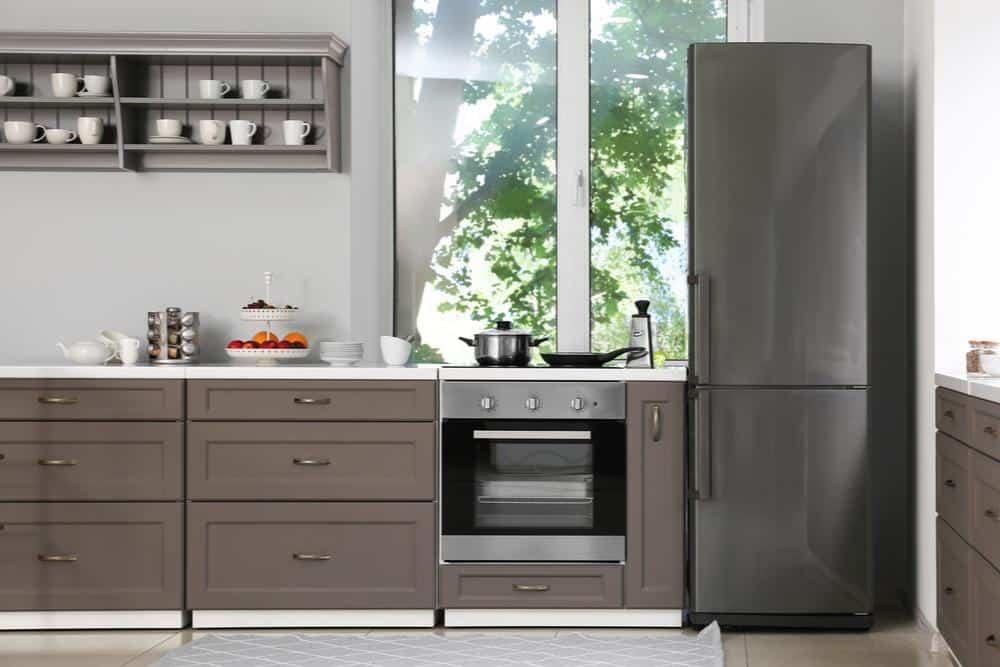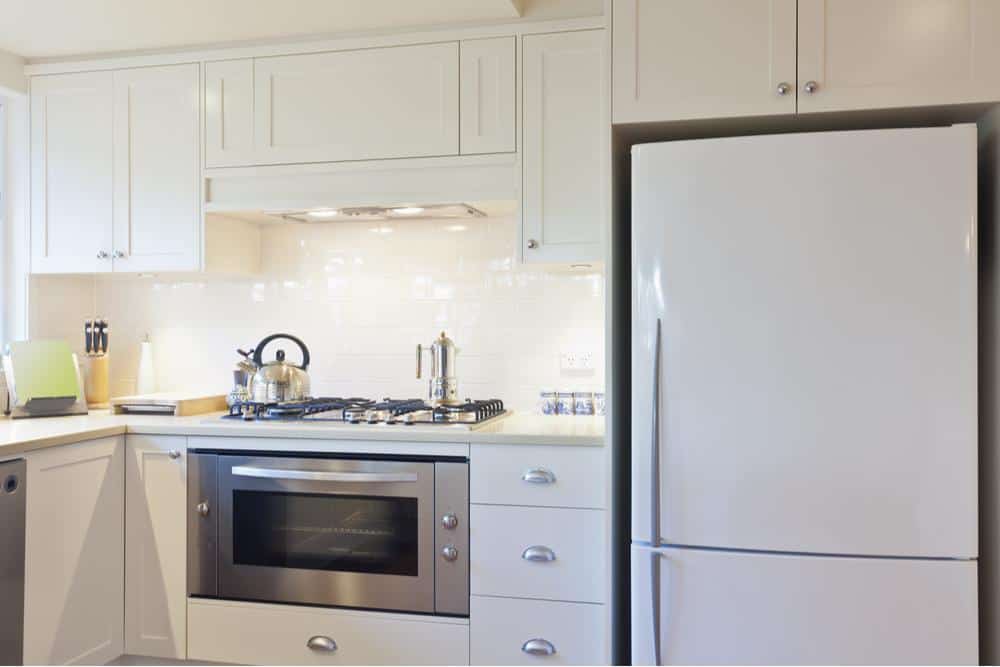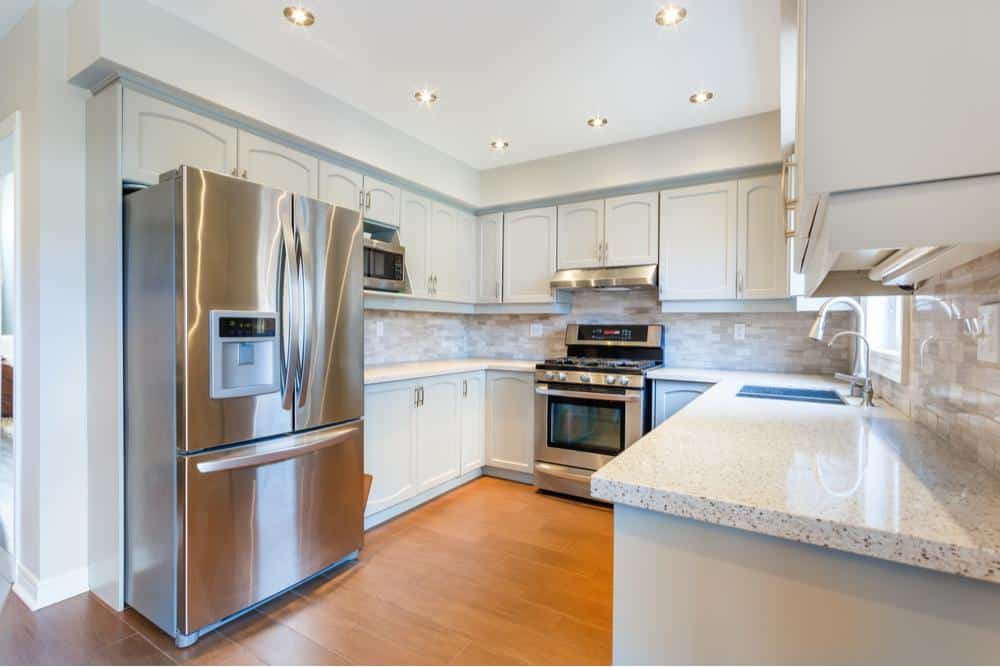Your Fridge and Stove Shouldn’t be in Close Proximity
There is nothing more challenging in the kitchen than arranging your kitchen layout. It would help if you were keen when deciding the distance in your kitchen triangle: sink, stove, and fridge.
When it comes to kitchen appliance placement, the most crucial distance is the distance between your stove and your refrigerator. This is because of how these two household appliances function. 
You are watching: What Is the Optimal Distance Between a Stove and Refrigerator?
The stove and refrigerator in this image are too close together
Ideally, there is no standard distance measure between the two appliances. Instead, it depends on how you plan to use the kitchen space, depending on your cooking habits and storage needs.
For the safety and efficiency of your appliances, you should maintain a certain minimum distance between your stove and refrigerator. So, what is the optimal distance between a stove and refrigerator?
Read along; we have exactly the proper distance to consider when arranging your household appliances and how to get the most out of your kitchen.
What Happens if Stove and Refrigerator Are Too Close
Maintaining a certain distance between stoves and refrigerators is essential in maximizing efficiency. If they are too close, heat from the stove can make the fridge work harder, making it less energy efficient.
Additionally, it can also cause the food in the fridge to spoil faster. The recommended minimum distance between a refrigerator and a stove is 20 inches.
Finally, having your stove and fridge close together can make your kitchen feel cramped and cluttered. This will make your kitchen uninspiring.
If possible, the two appliances should be placed on opposite sides of the kitchen to function independently without impacting each other’s performance.
Since the two household appliances have different needs, we must first understand their individual needs before tackling their collective placement.
Factors to Consider When Placing Your Stove
Correct placement of your stove is critical in deciding where you will position your refrigerator. However, a blind positioning might later come to haunt you. Here are a few factors to consider:
Kitchen Design and Space
Where is the traffic in your kitchen? You don’t want people walking by your stove all the time, especially if you’re cooking with gas. So, make sure your stove is in a spot where people can avoid it.
The Kind of Stove
If you have a gas stove, you need to be extra careful about placement. Gas stoves need ventilation, so make sure there’s a window nearby or a well-ventilated area. Gas stove placement is also somewhat restricted as you’ll need to have access to a gas line.
Kitchen Cabinets
Kitchen cabinets, especially upper cabinet location, will have a crucial role in positioning your stove. 
Stove, refrigerator and cabinet placement are less than optimal in the above image
Upper cabinets can obstruct airflow and create uncomfortable heat in the kitchen if positioned too close to the stovetop. Additionally, upper cabinets can block you while cooking.
Factors to Consider When Placing Your Refrigerator
There are many different factors to consider when choosing the best spot for your refrigerator.
Size
Read more : Who Is Bigfoot in Anthony Bourdain’s Book
The most important things, of course, are size and placement. You will want to be sure that your refrigerator will fit in the space you have chosen, and you should also think about how energy-efficient it is.
Traffic
Where you place your refrigerator can impact how often it needs to be repaired or replaced. If you have a lot of foot traffic in your kitchen, putting your refrigerator in an area with less traffic can help to extend its lifespan.
Proximity to a Food Preparation Area
If you are an avid cook who utilizes your fridge frequently, it is best to place it near your food preparation area to minimize the time and effort required to retrieve ingredients.
On the other hand, if you rarely use your fridge or mainly use it to store leftovers, placing it further away from the kitchen may be ideal.
What To Consider When Placing Your Stove and Fridge Together
Experts argue that a minimum of 20 inches should be the ideal distance between your fridge and your stove. However, several factors might decide whether to increase or reduce this distance.
Here is what is a list to help you in spacing your fridge and stove:
- Age of appliances
- Position of fridge doors
- Stove type
- Ventilation
- Sunlight
- Hygiene and cleaning
- Sink
- Cabinets
- Utility outlets
Age of Appliances
In general, newer models tend to be built with more efficient technology, generating less heat overall.
When placed side by side, these appliances may overheat the space and disrupt air circulation, so it’s best to keep them reasonably far apart.
However, if your appliances were manufactured a few years ago or even decades ago, this rule may not apply. Older models may have less advanced technology but tend to run a little hotter, so it’s good to ensure plenty of clearance between them for maximum airflow.
Positioning of Fridge Doors
If, in any case, you want to open the fridge while someone else is using the stove, there shouldn’t be any interference.
The best option is to have the fridge on one side and the stove facing it. However, you may need to keep these appliances farther apart than this general rule suggests depending on your kitchen layout.
Stove Type
Apart from age, the kind of stove matters a lot. Gas stoves, for instance, should be placed further away from refrigerators.
This is because the refrigerator can interfere with the ventilation of the gas stove, leading to accidents and other issues.
It is good to be close enough for electric stoves to allow easy access while cooking but far enough to avoid overheating or unnecessarily high electricity bills.
Ventilation
Ventilation around the fridge is also essential, especially for efficient functioning.
Ensure there’s plenty of clearance on all sides so that the fridge can ventilate properly and keep cool without any issues.
On the other hand, your stove will produce a lot of heat. Therefore, proper ventilation will be needed to allow the heat produced to dissipate.
Consider installing a vent hood or overhead exhaust, primarily if you use gas stoves in your kitchen. It will help to keep both appliances running smoothly for a long time.
Direct Sunlight
Read more : How to Get Rid Of Tiny Black Ants in Your House?
While sunlight can be extremely helpful in the counter space for food preparation, direct sunlight on the fridge can be counterproductive.
Direct sunlight on a fridge causes a rise in temperatures, leading to a decrease in efficiency and, in turn, increasing your energy costs.
To avoid this issue, try to place your fridge away from windows or other areas where sunlight may stream in. You can also install shades or curtains to block out the sun during certain day hours.
Hygiene and Cleaning
Food can spill over onto the fridge during food preparation if the stove and fridge are too close.
There should therefore be enough space in the design to facilitate easy cleaning.
Kitchen Sink Placement
The kitchen sink is part of a kitchen triangle with the stove and the fridge.
The distance between these three parts of the kitchen shouldn’t be more than 26 feet or less than 4 feet to make the workflow more efficient.
However, the sink shouldn’t be so close to the stove and fridge to avoid water spillages and possible flooding. Failure to consider this, you might get electrocuted.
Cabinets
One of the most important considerations when designing a kitchen is ensuring plenty of storage space. In particular, it is essential to have proper cabinet placement around your oven and fridge.
Cabinets placed lower than the top of the oven will be ideal, as it will create more room on the front for cooking or other tasks. Additionally, it is recommended that space between cabinets and the fridge so that air can circulate freely.
Utility Outlets
Electricity and gas outlets in the kitchen will play a crucial role in deciding how close or apart your fridge and stove are. In some cases, one is left with little to no room to maintain between the two appliances.
This may necessitate renovations. This can be costly, considering this is significant spending around the house.
Tips for an Efficient Kitchen
A kitchen island can be a great way to save space in the kitchen and create a functional, well-organized workspace.

A triangle kitchen layout is ideal for meal preparation
Whether you plan to use it for cooking, food preparation, or simply as extra countertop space, an island is a perfect solution for maximizing your limited kitchen space.
A good amount of storage in the form of cabinets can go a long way toward ensuring you have an efficient kitchen. The storage can be for both cookware and foodstuffs.
Correct Arrangement of the kitchen work triangle is another key to efficient cooking. This involves placing the three most essential kitchen areas (the sink, the stove, and the fridge) in a triangular layout.
This ensures that all of your essentials are close, making it quick and easy to get dinner on the table.
Finally, ensure there is good airflow and ventilation in the kitchen. Ensure your kitchen gets ample sunlight to avoid electricity from lighting up your kitchen even during the day.
Source: https://gardencourte.com
Categories: Kitchens


